-
The BladeForums.com 2024 Traditional Knife is available! Price is $250 ea (shipped within CONUS).
Order here: https://www.bladeforums.com/help/2024-traditional/
You are using an out of date browser. It may not display this or other websites correctly.
You should upgrade or use an alternative browser.
You should upgrade or use an alternative browser.
"Old Knives"
- Thread starter VCM3
- Start date
Old Engineer
Gold Member
- Joined
- Nov 30, 2014
- Messages
- 10,084
Thank you Harry, Paul and Glenn.
At this time the Valley Forge is the pinnacle of my small but growing accumulation. Wanting to be a good caretaker I simply cleaned it with mineral oil but was wondering about sharpening. I have some more contemporary knives that I enjoy carrying so for the time being I'll be content just visiting the Valley Forge, at it's place of prominence in my den.
The main blade on the "swelled bolster barlow" (my designation) needed to be polished due to some sever sharpening scratches. I figured it's value couldn't be hurt since it was so scratched and actually, I'm quite pleased with the way it turned out. Since the first time slipping it in my pocket I found I love the saw cut bone, sunken joint and it's thin blades. Thanks again for your comments and input. -James
I am afraid the I would have to carry that old Valley Forge some . It is just too nice to keep locked up . I take out these Old Guys , Mr. Russell and Mr. Oates , every now and then .

Harry
Campbellclanman
Platinum Member
- Joined
- Mar 10, 2007
- Messages
- 15,822
Nice one Harry. 👍So you should my friend.
- Joined
- Dec 2, 2005
- Messages
- 71,173
Both very beautiful Harry :thumbup:
- Joined
- Jan 17, 2011
- Messages
- 15,193
Pieces of art history, Harry 
- Joined
- Oct 3, 2014
- Messages
- 7,462
Thank you huelsdonk. I don't know why more knives aren't made with sunk joints, especially barlows.Really nice pair of knives, James. I agree with Paul - that barlow is a beaut.
Nice pair Harry, Russell & Oates look good together, kinda like bookends.
You've convinced me, might have to take these out from time to time, we'll see.
Robeson - Valley Forge (bottom)

Old Engineer
Gold Member
- Joined
- Nov 30, 2014
- Messages
- 10,084
Thank you James .
You would be perfectly balanced my friend . One in each pocket and walking proud !!!
Harry
- Joined
- Oct 3, 2014
- Messages
- 7,462
Lol,  thanks Harry.
thanks Harry.
Campbellclanman
Platinum Member
- Joined
- Mar 10, 2007
- Messages
- 15,822
James, Two absolute beauties there mate, I love Ebony and those two are just Great, the VF looks to be quite a Tank - which in my books is pretty darn cool.
Luger1952
Gold Member
- Joined
- Jan 12, 2012
- Messages
- 1,397
I just got this Schatt & Morgan Jack. It is 3.75 inches closed, has full blades and is in excellent condition albeit probably cleaned. At first I wasn't even sure if it was a real or authentic Schatt and Morgan vintage folder--it just looked to good to be true. Who then could have produced this Jack if recently or not in the to distant past and tang stamped it Schatt & Morgan? I thought perhaps it was a Queen produced folder from the Schatt & Morgan series they introduced in the early 90's. I looked at a lot of them with the exact same tang stamp but none like this one. So I proceeded to dive into the forums (BF and AAPK) doing searches under Schatt & Morgan but found nothing at first. There was some nice vintage Jacks on both forums but none like this one I just got that I could find.
Then on AAPK I found some posts about David Clark a well known Schatt & Morgan and Queen Cutlery expert, collector and historian. So I did a search on his name and found an interesting thread titled "Red Goose Shoes" by member bkazz5 from June 2014. He had posted a photo of a Jack that was the same configuration as mine asking if anyone could confirm its originality. It has a Red Goose Advertising shield not like my long narrow rectangular style shield. Still, the rest of the knife was identical to mine. I was intrigued and kept reading into page 2 of the thread. There was this, I believe, email response shared by bkazz5 from David Clark confirming that he was of the opinion that it was an original Schatt & Morgan Jack. Further, Mr. Clark attached to his response some photos of several of his vintage Schatt & Morgan Jacks. WOW, there it was the same exact Jack! Same worm groove bone handles, same long pull running into the tang, same blade configuration, same swedges, same pin placement, same shield type--SAME exact Jack. Only exception was what was engraved or stamped on Shield. His says something about elevators. Mine reads "Quality Tells-Specify Vestai" whatever that means? At first I thought it said "Quality Tells-Specify Vespa" proving you see what you want to see sometimes. Vespa scooters weren't introduced until the late 40s so that couldn't be right since this Schatt & Morgan would have been produced prior to 1933 and upon closer examination reads as above anyway. I want to thank bkazz for his persistent investigation of his advertising shield Schatt & Morgan Jack which helped me confirm the originality of mine! Any further insight anyone here can add will be welcomed and appreciated. Happy Holidays, Lloyd
Here is the original thread on AAPK ofthe Red Goose Schatt & Morgan Jack if you are interested.
http://www.allaboutpocketknives.com/knife_forum/viewtopic.php?f=4&t=41755&hilit=David+Clark
Also I have included a photo from David Clark of three Schatt & Morgan Jacks he included in his response to the member on AAPK. My example is just like the middle one in the photograph.
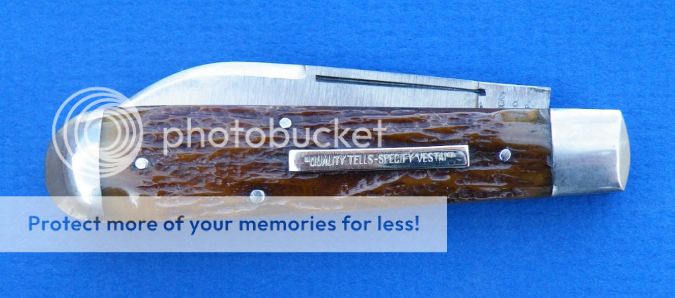
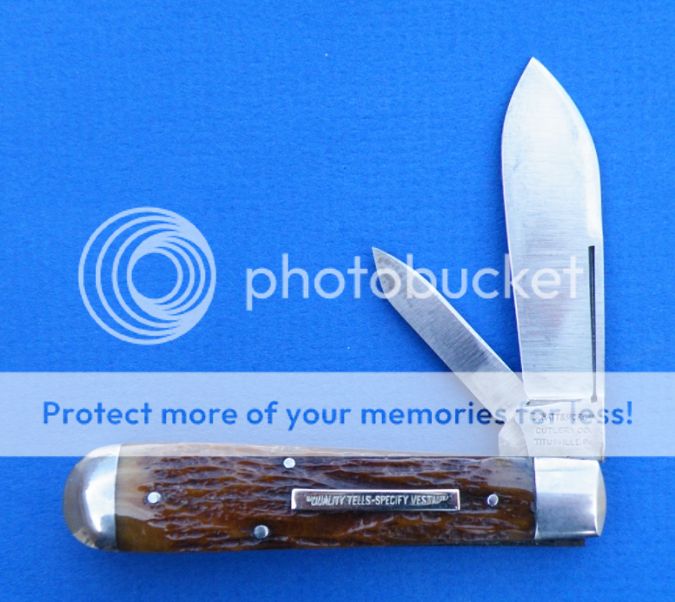
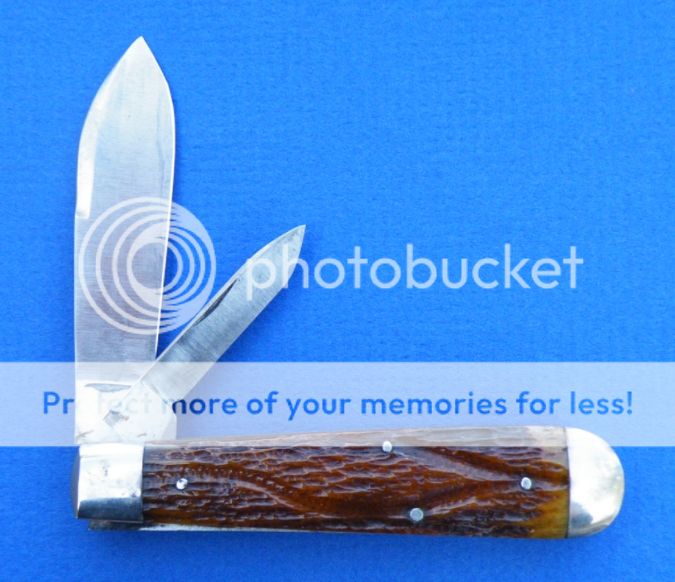
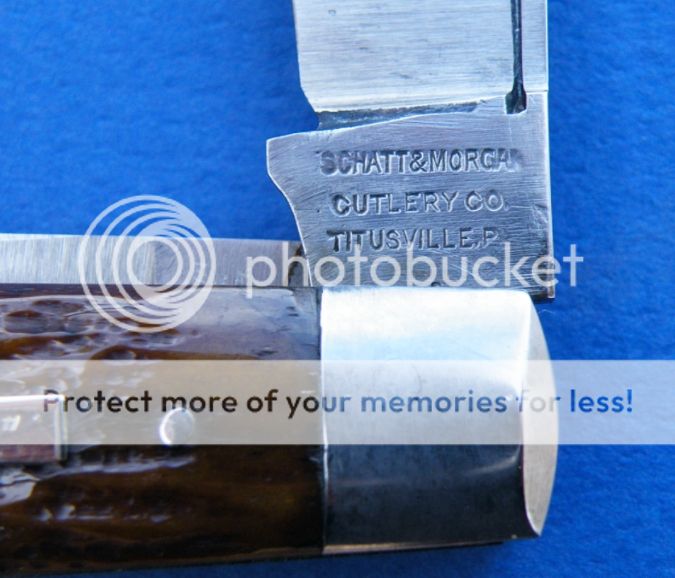
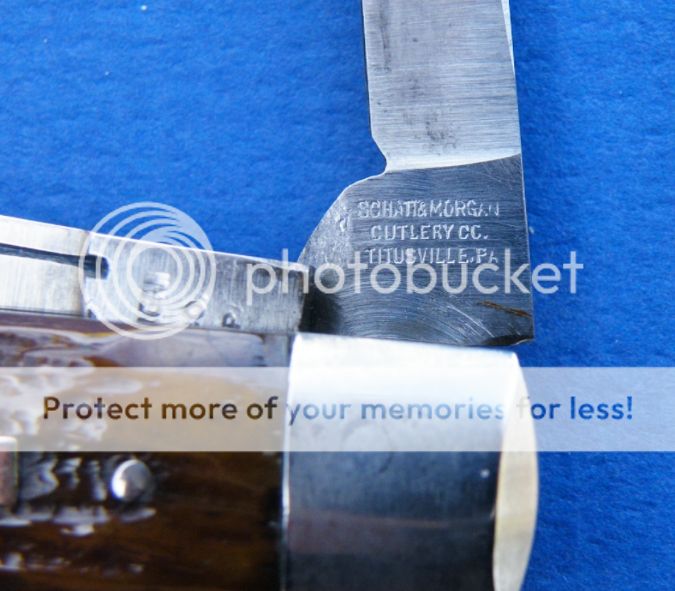
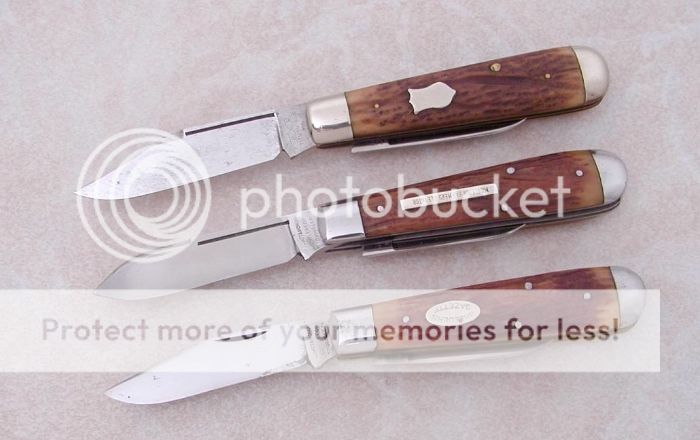
Then on AAPK I found some posts about David Clark a well known Schatt & Morgan and Queen Cutlery expert, collector and historian. So I did a search on his name and found an interesting thread titled "Red Goose Shoes" by member bkazz5 from June 2014. He had posted a photo of a Jack that was the same configuration as mine asking if anyone could confirm its originality. It has a Red Goose Advertising shield not like my long narrow rectangular style shield. Still, the rest of the knife was identical to mine. I was intrigued and kept reading into page 2 of the thread. There was this, I believe, email response shared by bkazz5 from David Clark confirming that he was of the opinion that it was an original Schatt & Morgan Jack. Further, Mr. Clark attached to his response some photos of several of his vintage Schatt & Morgan Jacks. WOW, there it was the same exact Jack! Same worm groove bone handles, same long pull running into the tang, same blade configuration, same swedges, same pin placement, same shield type--SAME exact Jack. Only exception was what was engraved or stamped on Shield. His says something about elevators. Mine reads "Quality Tells-Specify Vestai" whatever that means? At first I thought it said "Quality Tells-Specify Vespa" proving you see what you want to see sometimes. Vespa scooters weren't introduced until the late 40s so that couldn't be right since this Schatt & Morgan would have been produced prior to 1933 and upon closer examination reads as above anyway. I want to thank bkazz for his persistent investigation of his advertising shield Schatt & Morgan Jack which helped me confirm the originality of mine! Any further insight anyone here can add will be welcomed and appreciated. Happy Holidays, Lloyd
Here is the original thread on AAPK ofthe Red Goose Schatt & Morgan Jack if you are interested.
http://www.allaboutpocketknives.com/knife_forum/viewtopic.php?f=4&t=41755&hilit=David+Clark
Also I have included a photo from David Clark of three Schatt & Morgan Jacks he included in his response to the member on AAPK. My example is just like the middle one in the photograph.






Last edited:
- Joined
- Oct 3, 2014
- Messages
- 7,462
Thanks Duncan, the VF does seem to be built a little heavy duty. Seems my taste in knives runs toward plainer, rugged, not quite a work horse knife but one that's definitely been made to get things done and I'm telling ya mate, ebony is actually kyrptonite,James, Two absolute beauties there mate, I love Ebony and those two are just Great, the VF looks to be quite a Tank - which in my books is pretty darn cool.
black mamba
Gold Member
- Joined
- Oct 21, 2009
- Messages
- 23,595
Luger, that is an extraordinary S&M. Some of the best bone I've seen. Do you think the pen has been reground, or is that the original, near tanto, shape?
lambertiana
Gold Member
- Joined
- Jul 7, 2000
- Messages
- 9,731
A couple beauties there. The Robeson has fabulous ebony. I have my suspicions about the VF, I think it may be cocobolo. I'd have to see it in direct sunlight to be sure, but right now from this picture I lean toward cocobolo.
Luger1952
Gold Member
- Joined
- Jan 12, 2012
- Messages
- 1,397
Luger, that is an extraordinary S&M. Some of the best bone I've seen. Do you think the pen has been reground, or is that the original, near tanto, shape?
You know Jeff that is a good question? I wondered about that too. If you look at the "Red Goose" Schatt & Morgan Jack in the link to AAPK I included in my post, it has sort of a tantoish type pen blade look also. I cannot see any evidence that the pen on my example has been messed with at all. However, I have not seen any other pen blade profiles on this S & M Jack type with again with the exception of this Red Goose one. I wish David Clark's photos had one with blades extended! Anyway, thanks for your nice comment on the bone handles and great question. Lloyd
- Joined
- Oct 3, 2014
- Messages
- 7,462
Thank you Sir for your kind words. You are correct about the Robeson. It has "fabulous ebony", so smooth and dark that it took some time for me to be convinced it wasn't a composite. You may also be right about the VF being cocobolo and I appreciated you pointing it out. Since your post I did noticed the brown tint in the photo and began comparing the VF's handle to known ebonies. It possibly is cocobolo but I'm not certain. Whichever it is makes vary little difference to me, except for a desire to be accurate, as I like both woods equally. Would you (or someone else) share with me how to distinguish between the two woods? Your advice could help me to be accurate and satisfy my curiosity. Thanks, -JamesA couple beauties there. The Robeson has fabulous ebony. I have my suspicions about the VF, I think it may be cocobolo. I'd have to see it in direct sunlight to be sure, but right now from this picture I lean toward cocobolo.
lambertiana
Gold Member
- Joined
- Jul 7, 2000
- Messages
- 9,731
Thank you Sir for your kind words. You are correct about the Robeson. It has "fabulous ebony", so smooth and dark that it took some time for me to be convinced it wasn't a composite. You may also be right about the VF being cocobolo and I appreciated you pointing it out. Since your post I did noticed the brown tint in the photo and began comparing the VF's handle to known ebonies. It possibly is cocobolo but I'm not certain. Whichever it is makes vary little difference to me, except for a desire to be accurate, as I like both woods equally. Would you (or someone else) share with me how to distinguish between the two woods? Your advice could help me to be accurate and satisfy my curiosity. Thanks, -James
The easiest way is to get it in full sunlight. If you see obvious reddish overtones, it is cocobolo. Cocobolo usually darkens over time to almost black, but you can still see the red in direct sunlight. I have yet to see ebony that was anything other than black/brown/gray. Of course, since antique knives were most likely also handled with african blackwood (which was historically called ebony) you may see some purple/red overtones but the grain of african blackwood is usually very fine, and even freshly cut blackwood usually only has a slight purplish cast, not reddish.
Cocobolo has more open pores, but this is not a solid rule to follow because I have seen a few examples of ebony that have large pores similar to that VF. But I have not seen any cocobolo as fine grained as a good ebony or african blackwood.
With cocobolo, any stripes that you can make out on age-darkened wood will follow the growth rings (easily seen in new cocobolo that has not darkened). Ebony, on the other hand, is a funny wood. Any stripes/bands of color variation do not generally follow the growth rings but are random. It took me a while to figure that out. One day I was looking closely at a block of macassar ebony trying to make sense of the stripe pattern and saw that the growth rings were very evenly spaced, but the dark/light stripes were random and cut across the growth rings. I also have some Malaysian Blackwood (an ebony), Kamagong (philippine ebony), and black & white ebony that all show this characteristic. I suspect it is also true for the black ebony that I have (gabon and madagascar) but it is hard to tell with totally black wood. You usually have to be looking at the end grain to really see this, which is not easy on pocketknife slabs.
Last edited:
- Joined
- Nov 29, 2016
- Messages
- 40
I was drawer rummaging earlier and found this old thing lurking at the back. I remember I found it around 1990 and it was far from new. It had clearly been abused, the blade is bent and scratched. Looking at it again I'm guessing it originally had shields or plaques on the scales. It's a locking folder with what appears to be black wooden scales. I think it was designed to look like a flick knife/switchblade. The makers mark is "CK 9638? Stainless" and possibly "Italy"
It's never going to be a legal carry in the UK so not sure if worth refurbishment although I might do what I can just for fun.
Any thoughts?




Sent from my SM-G920F using Tapatalk
It's never going to be a legal carry in the UK so not sure if worth refurbishment although I might do what I can just for fun.
Any thoughts?




Sent from my SM-G920F using Tapatalk
- Joined
- Nov 29, 2016
- Messages
- 40

Sent from my SM-G920F using Tapatalk
screened porch
Basic Member
- Joined
- Feb 19, 2012
- Messages
- 19,344
Around here we called those stilettos and everybody in Junior High School wanted one. The German ones were thought of more highly, but were pretty expensive. The Italian ones we could get cheaper had soft copper wire for pivot pins (yours is a lot better than those).
Here's mine, bought well after Junior High School. (third from left)

Here's mine, bought well after Junior High School. (third from left)
- Joined
- Nov 29, 2016
- Messages
- 40
Around here we called those stilettos and everybody in Junior High School wanted one. ...... The Italian ones we could get cheaper had soft copper wire for pivot pins (yours is a lot better than those).
Thanks, why couldn't I think of that word? I love stilettos normally [emoji14]
Now that makes me think it might now be a banned knife in the UK, going to have to look it up. [emoji15]
Sent from my SM-G920F using Tapatalk
